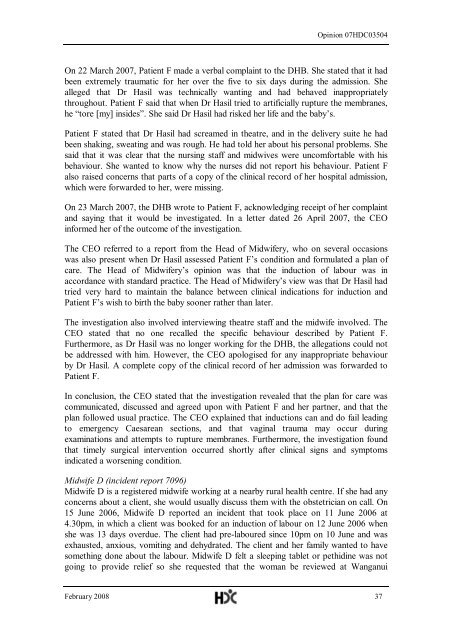Roman Hasil and the Whanganui DHB - Health and Disability ...
Roman Hasil and the Whanganui DHB - Health and Disability ...
Roman Hasil and the Whanganui DHB - Health and Disability ...
Create successful ePaper yourself
Turn your PDF publications into a flip-book with our unique Google optimized e-Paper software.
Opinion 07HDC03504<br />
On 22 March 2007, Patient F made a verbal complaint to <strong>the</strong> <strong>DHB</strong>. She stated that it had<br />
been extremely traumatic for her over <strong>the</strong> five to six days during <strong>the</strong> admission. She<br />
alleged that Dr <strong>Hasil</strong> was technically wanting <strong>and</strong> had behaved inappropriately<br />
throughout. Patient F said that when Dr <strong>Hasil</strong> tried to artificially rupture <strong>the</strong> membranes,<br />
he “tore [my] insides”. She said Dr <strong>Hasil</strong> had risked her life <strong>and</strong> <strong>the</strong> baby’s.<br />
Patient F stated that Dr <strong>Hasil</strong> had screamed in <strong>the</strong>atre, <strong>and</strong> in <strong>the</strong> delivery suite he had<br />
been shaking, sweating <strong>and</strong> was rough. He had told her about his personal problems. She<br />
said that it was clear that <strong>the</strong> nursing staff <strong>and</strong> midwives were uncomfortable with his<br />
behaviour. She wanted to know why <strong>the</strong> nurses did not report his behaviour. Patient F<br />
also raised concerns that parts of a copy of <strong>the</strong> clinical record of her hospital admission,<br />
which were forwarded to her, were missing.<br />
On 23 March 2007, <strong>the</strong> <strong>DHB</strong> wrote to Patient F, acknowledging receipt of her complaint<br />
<strong>and</strong> saying that it would be investigated. In a letter dated 26 April 2007, <strong>the</strong> CEO<br />
informed her of <strong>the</strong> outcome of <strong>the</strong> investigation.<br />
The CEO referred to a report from <strong>the</strong> Head of Midwifery, who on several occasions<br />
was also present when Dr <strong>Hasil</strong> assessed Patient F’s condition <strong>and</strong> formulated a plan of<br />
care. The Head of Midwifery’s opinion was that <strong>the</strong> induction of labour was in<br />
accordance with st<strong>and</strong>ard practice. The Head of Midwifery’s view was that Dr <strong>Hasil</strong> had<br />
tried very hard to maintain <strong>the</strong> balance between clinical indications for induction <strong>and</strong><br />
Patient F’s wish to birth <strong>the</strong> baby sooner ra<strong>the</strong>r than later.<br />
The investigation also involved interviewing <strong>the</strong>atre staff <strong>and</strong> <strong>the</strong> midwife involved. The<br />
CEO stated that no one recalled <strong>the</strong> specific behaviour described by Patient F.<br />
Fur<strong>the</strong>rmore, as Dr <strong>Hasil</strong> was no longer working for <strong>the</strong> <strong>DHB</strong>, <strong>the</strong> allegations could not<br />
be addressed with him. However, <strong>the</strong> CEO apologised for any inappropriate behaviour<br />
by Dr <strong>Hasil</strong>. A complete copy of <strong>the</strong> clinical record of her admission was forwarded to<br />
Patient F.<br />
In conclusion, <strong>the</strong> CEO stated that <strong>the</strong> investigation revealed that <strong>the</strong> plan for care was<br />
communicated, discussed <strong>and</strong> agreed upon with Patient F <strong>and</strong> her partner, <strong>and</strong> that <strong>the</strong><br />
plan followed usual practice. The CEO explained that inductions can <strong>and</strong> do fail leading<br />
to emergency Caesarean sections, <strong>and</strong> that vaginal trauma may occur during<br />
examinations <strong>and</strong> attempts to rupture membranes. Fur<strong>the</strong>rmore, <strong>the</strong> investigation found<br />
that timely surgical intervention occurred shortly after clinical signs <strong>and</strong> symptoms<br />
indicated a worsening condition.<br />
Midwife D (incident report 7096)<br />
Midwife D is a registered midwife working at a nearby rural health centre. If she had any<br />
concerns about a client, she would usually discuss <strong>the</strong>m with <strong>the</strong> obstetrician on call. On<br />
15 June 2006, Midwife D reported an incident that took place on 11 June 2006 at<br />
4.30pm, in which a client was booked for an induction of labour on 12 June 2006 when<br />
she was 13 days overdue. The client had pre-laboured since 10pm on 10 June <strong>and</strong> was<br />
exhausted, anxious, vomiting <strong>and</strong> dehydrated. The client <strong>and</strong> her family wanted to have<br />
something done about <strong>the</strong> labour. Midwife D felt a sleeping tablet or pethidine was not<br />
going to provide relief so she requested that <strong>the</strong> woman be reviewed at Wanganui<br />
February 2008 37

















